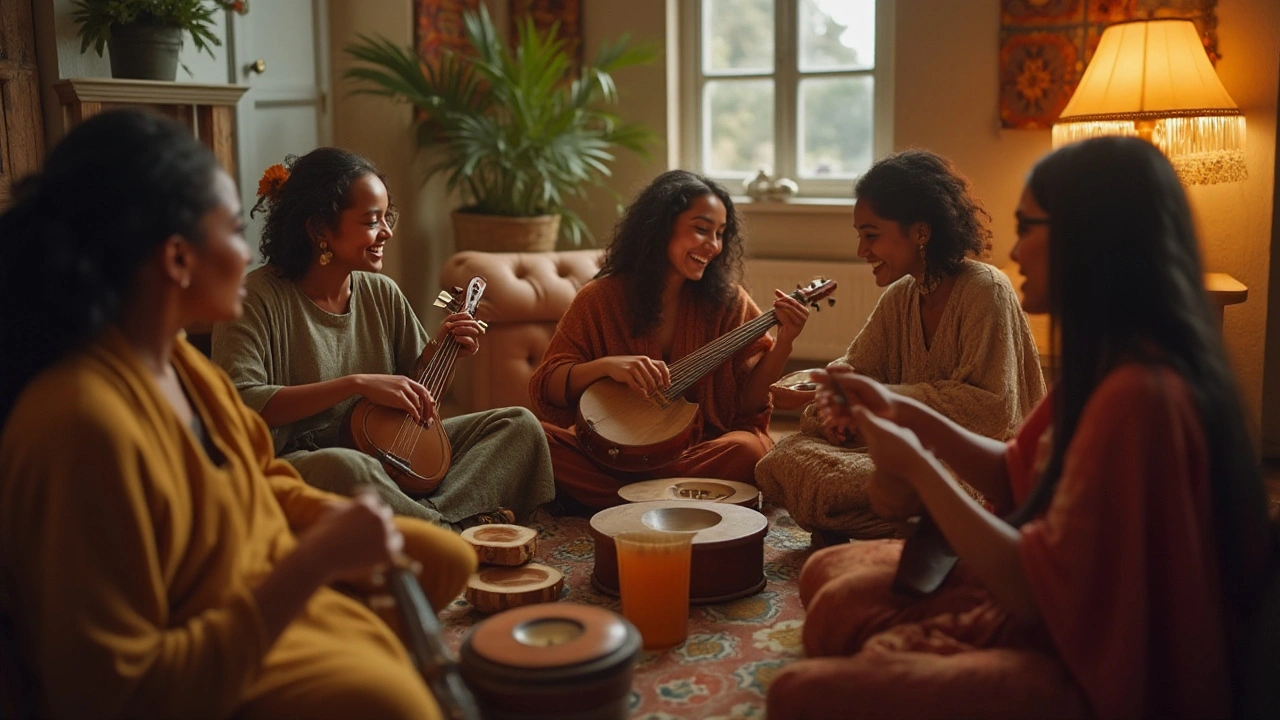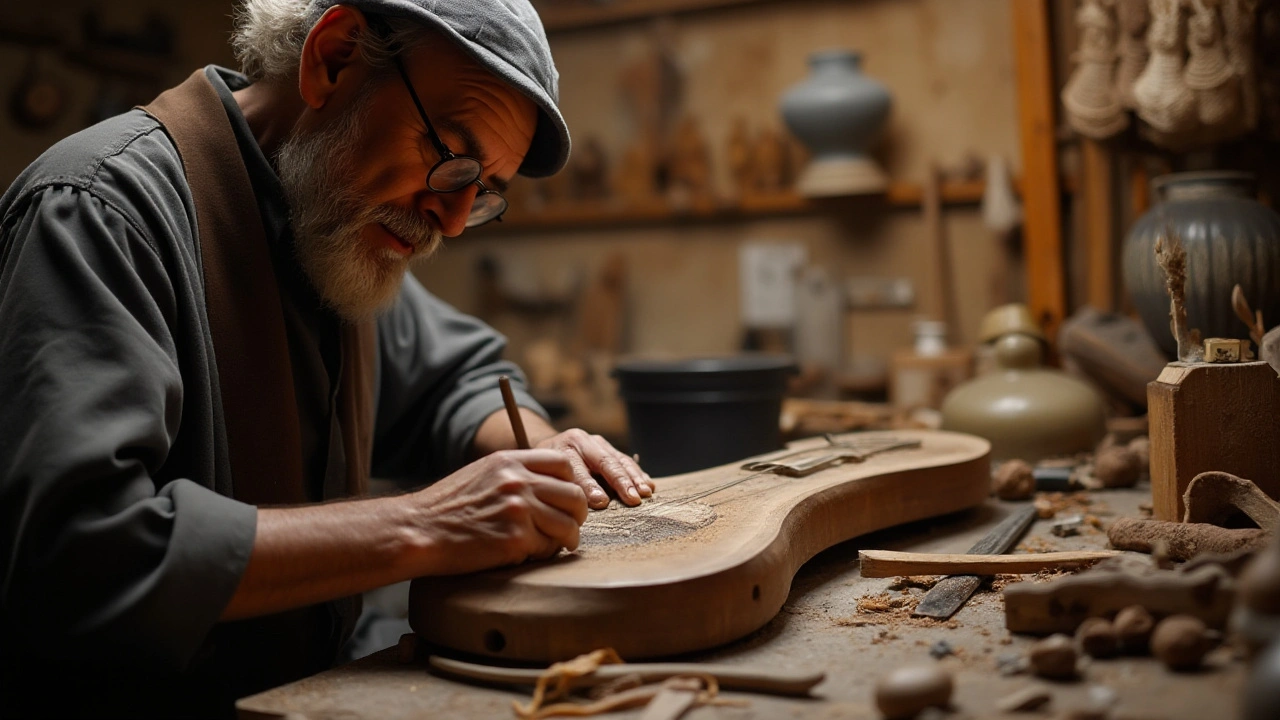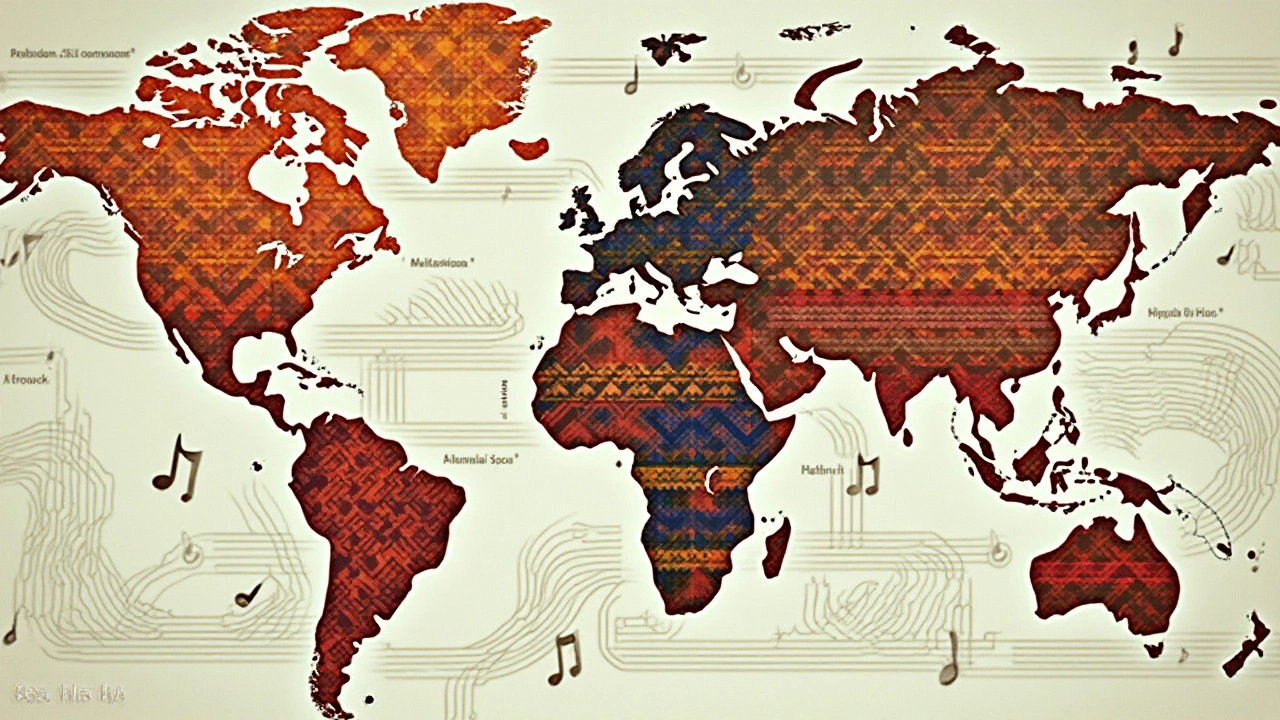Music has always been a universal language, capable of bridging the gap between diverse cultures. Its magic lies not just in melodies and lyrics but in the instruments that bring music to life. By examining musical instruments from various corners of the world, we open a gateway to cultural understanding.
From the soulful hum of Africa's djembe to the resonant chords of Japan's koto, each instrument offers a glimpse into the life and legacy of its people. Exploring these instruments helps us appreciate the rich traditions and unique histories that create the colorful tapestry of global music.
Understanding cultural nuances through music and its instruments transforms our listening experience, inviting us into worlds unknown and fostering a deep respect for cultural diversity. Let us embark on this harmonious journey, one note at a time.
- The Cultural Significance of Instruments
- Fascinating Instruments from Around the Globe
- Tips for Cultural Appreciation Through Music
- The Role of Instruments in Storytelling
- Exploring Music's Impact on Cultural Identity
The Cultural Significance of Instruments
Musical instruments are the cornerstones of cultural storytelling, often embodying a people's history, values, and identity. Throughout history, instruments have served as voices of communities, channeling both joy and sorrow into tuneful expression. Their sounds echo traditions handed down through generations, each note resonating with the lived experiences of the past. In different regions, instruments have evolved in unique ways, adapting to the social, spiritual, and environmental changes that communities faced. The deep, resonant drumbeats of the African djembe, for example, recall the continent's rich oral traditions, often used in ceremonies and communal gatherings to narrate tales and pass wisdom to the younger generations. Each instrument, therefore, opens a window to the very soul of a culture, offering insights beyond what words can convey.
Some instruments carry rituals and spiritual significance, transcending mere entertainment. The didgeridoo, an ancient wind instrument of the Aboriginal people of Australia, is considered sacred and is believed to keep the spirit of the land alive. In Tibet, the droning notes of the dungchen, a long horn used in Buddhist ceremonies, have the power to invoke feelings of transcendence and peace. It’s as if these instruments bridge the earthly with the divine, giving voice to spiritual expression. They serve as reminders that music, at its heart, is a spiritual journey shared by humanity.
The great Russian composer Igor Stravinsky once said, "The phenomenon of music is a miracle that cannot be explained but only felt." These instruments, imbued with cultural meaning, are the conduits of this miracle.
The cultural significance of instruments can also be seen in their role in preserving and adapting music across borders. When communities migrate or when people from different lands meet, musical ideas cross-pollinate, bringing about the transformation and integration of instruments. The guitar, for example, has traveled across the world, integrating distinct musical styles and, over time, becoming a staple in many genres, from flamenco to blues. These instruments become symbols of unity amidst diversity, reminding us of our shared human experience. The fusion of instruments and styles across cultures continues to enrich the music landscape, underscoring the vitality of cultural exchange.
In terms of cultural heritage and education, instruments serve as educational tools that teach us about the intricacies of a culture's art forms. From a young age, individuals introduced to these instruments learn not only the technicalities of playing but also the stories and values etched in their culture's musical legacy. Engaging with instruments like the Indian sitar or the Chinese guzheng allows students within these cultures to connect deeply with their heritage, fostering a sense of pride and belonging. They act as tactile and auditory conduits, effectively connecting young learners with their ancestry and reinforcing cultural narratives unique to their communities.
The evolving meaning of instruments can reflect broader societal changes, as new technology and innovation influence their development. Digital instruments and synthesisers are crafting a new cultural narrative, blending traditional music with cutting-edge soundscapes. In this sense, instruments are not static relics but dynamic artifacts evolving alongside the societies that create and cherish them. This evolution speaks to the power of music as an art form—it has an inherent flexibility that allows it to change while staying deeply rooted in its origins. As instruments continue to transform within the modern world, they remain poignant cultural symbols, capturing the timelessness of human expression.
The role of musical instruments in cultural life cannot be understated. They not only entertain and inspire but also educate and build bridges between people, inviting us to walk in each other's shoes, if only for a moment. In learning to appreciate the diversity of instruments worldwide, we foster greater understanding and empathy. These instruments, when played and heard, are not just generating notes and melodies; they are composing the soundtracks of human history, ensuring that the cultural pulse beats continually across time and space. By engaging with them, we honor the voices of the past while being inspired to create a future harmonious with the harmony of the world.
Fascinating Instruments from Around the Globe
Every corner of the world offers its own musical wonders through musical instruments, each with a story etched by time and tradition. Let's start in Asia, where the sitar, an iconic string instrument from India, captivates with its hypnotic sound. This instrument, with its intricate design and numerous strings, is emblematic of Indian classical music. Its usage dates back centuries, attributed to Musicians like Pandit Ravi Shankar who brought its enchanting soundwaves to Western ears.
In the heart of Africa, the djembe drum holds profound cultural significance. Originating from West Africa, the djembe is known for its capability to produce a wide range of tones. Traditionally crafted from a single piece of African hardwood, with a goat skin drumhead, it is often used in ceremonies and storytelling. The drum's rhythm is said to echo the heartbeat of its community, linking people in a shared cultural melody.
Across the Pacific, the Australian didgeridoo emerges as one of the oldest wind instruments in existence. Crafted from naturally hollowed-out eucalyptus trunks, its deep droning sound is central to Aboriginal music and spirituality. Played traditionally in ceremonies dating back thousands of years, it serves as a bridge between the physical and spiritual realms, adding depth to Aboriginal cultural identity.
Over in Europe, the Scottish bagpipes offer a unique aural experience. Originally from the Celtic regions, these musical instruments gained worldwide fame. With their distinctive sound, bagpipes are often associated with celebrations and ceremonies from Scotland to Ireland. The way they require simultaneous use of both hands and lungs turns playing the instrument into a skillful dance between breath and melody.
“Music is a world within itself, with a language we all understand.” – Stevie Wonder
Across the world in Asia, the Japanese koto — a string instrument with roots in ancient China — offers a gentle, resonant voice in traditional and contemporary music alike. Often regarded as Japan's national instrument, it's traditionally played with picks worn on the fingers. The compositions performed on the koto convey an ethereal blend of sound and silence, reflecting the beauty and enigma of the Japanese landscape.
| Region | Instrument | Cultural Significance |
|---|---|---|
| Africa | Djembe | Community connection, storytelling |
| Asia | Sitar | Classical music, cultural exchange |
| Australasia | Didgeridoo | Spirituality, cultural identity |
| Europe | Bagpipes | Ceremonial, cultural tradition |
These instruments, just a small sample from countless others around the globe, convey stories and emotions not only through their sounds but also through their unique designs and playing techniques. Whether by finger plucks or rhythmic beats, they serve as vibrant promoters of cultural understanding, connecting us with the lives and traditions of distant peoples. Delving into these musical creations enriches our appreciation of world music, offering not only entertainment but also an educational journey into the heartbeats of civilizations past and present.

Tips for Cultural Appreciation Through Music
Listening to music from different cultures is like embarking on a journey without leaving your home. Each note, rhythm, and instrument is a clue that uncovers stories of human experience and shared history. To appreciate these cultural gems, start by immersing yourself in the sounds unique to each region. Dedicate time to develop a listening routine that explores playlists and albums focused on world music. This intentional approach will gradually expand your auditory palate and enrich your understanding of diverse musical landscapes. One might enjoy the pulsating beats of Latin America one day and the serene, melodic compositions of the East the next.
Another way to deepen cultural appreciation through music is by learning the histories behind the instruments themselves. Every instrument, whether it's the sitar of India or the bagpipes of Scotland, carries with it a history and an origin story that speaks volumes about the people who crafted and played it. Attending live performances, when possible, offers a visceral connection to the music's cultural context, complete with the visual and emotional expressions that recordings can't capture. Often, live settings also provide an opportunity to engage with artists directly, asking questions and gaining insights into their personal musical journeys.
Engaging with Musicians and Communities
Engagement extends beyond passive listening; it involves connecting with musicians who are passionate about sharing their culture through music. Seek out interviews, documentaries, and social media profiles of musicians who specialize in world music. Many artists are more accessible today than ever due to online platforms, enabling you to explore their works and personal stories. Interaction with local communities who celebrate their cultural music traditions is another enriching path. Participate in festivals, workshops, or community gatherings where traditional music is performed and celebrated. Such involvement fosters a more profound appreciation and understanding of the cultural roots and narratives intertwined with the music.
"Music gives a soul to the universe, wings to the mind, flight to the imagination and life to everything." - Plato
Finally, understanding the musical instruments and their role in cultural storytelling can be an enlightening pursuit. Take note of how specific instruments are used in cultural rituals and ceremonies, often marking significant life events or historical milestones. In doing so, you'll gain insight into how cultures perceive and convey their values and beliefs through music. Try exploring educational resources that provide deeper analysis and historical context of music from around the world. Books, online courses, and academic articles can offer structured learning paths that enhance your appreciation and broad discovery of global music traditions. The journey may start with curiosity, but with each discovery and experience, it becomes a lifetime journey of cultural richness and understanding.
The Role of Instruments in Storytelling
Musical instruments are more than just tools for creating music; they are powerful storytellers in their own right. Each stroke of a violin's bow or beat of a drum has the capacity to weave tales that words alone can't express. The narratives they tell often transcend language barriers, conveying emotions and stories passed down through generations. Across the globe, different musical instruments play key roles in cultural storytelling, becoming vessels of history and tradition. Consider the Indigenous peoples of Australia, for instance, whose use of the didgeridoo is integral to Dreamtime stories, a complex system of knowledge, faith, and lore. The deep, resonant timbre of the didgeridoo accompanies stories about the creation of the earth, embodying the sacredness of their relationship with nature.
The Celtic harp, with its ethereal sound, plays a central role in Irish folklore. This instrument is often associated with tales of heroism and the mystical world of fairies. Many of these stories were traditionally passed down orally, with the harp providing a hauntingly beautiful backdrop that elevates the spoken word. Intriguingly, instruments do not merely serve as accompanying sounds, but they too become characters within narratives, each note adding depth to the arc of the story being told. This instrumental storytelling is especially poignant at traditional festivals where past and present collide, bringing ancient tales to life in contemporary settings.
In India, the sitar—a stringed instrument with a distinctive sound—often recounts epic tales from ancient texts such as the Ramayana and the Mahabharata. The music of the sitar is not just background; it is central to the re-enactment of scenes, allowing listeners to connect deeply with the actions and emotions of the characters involved. Music becomes a potent force here, not only preserving these tales for posterity but infusing them with new life in modern concerts and films. Such instruments have a transformative power: they transport audiences to different realms and evoke rich emotional responses, making narratives tangible in a way that mere recitation cannot achieve.
It's fascinating to note how storytelling through instruments has also evolved with more contemporary forms, where electric guitars and synthesizers extend traditional narratives into today's soundscapes. When Bob Dylan famously went electric at the Newport Folk Festival in 1965, he didn't just change the sound of folk music—he altered its story. The electric guitar, long associated with rebellion and freedom, infused the genre with new energy, echoing a shifting cultural tide. This shift in narrative was not only heard but felt distinctly by audiences worldwide.
"Music is the shorthand of emotion" – Leo Tolstoy
In summary, the role of musical instruments in storytelling is vital in preserving cultural identities and sharing shared human experiences. Through the ages, they have served as conduits for the stories of people, places, and emotions. By listening thoughtfully to them, we gain a deeper appreciation of the tales they tell and the cultures they represent. Whether through an ancient lyre or a modern synthesizer, these instruments continue to narrate the stories of our world, reminding us of our shared humanity and the power of music to connect us across boundaries and generations.

Exploring Music's Impact on Cultural Identity
Music is more than just a form of entertainment; it is a profound expression of cultural identity that resonates on a deep level within communities. By tapping into the rich sounds and rhythms of different cultures, music becomes a powerful lens for understanding the values, beliefs, and unique characteristics that shape cultural identity. It's fascinating how musical instruments, such as the wooden xylophone in Ghana or the vibrant sitar in India, carry not only melodies but also stories of their regions. These instruments are not just tools; they are symbols, narrating tales of migration, conquest, and resilience. Their development over time offers a fascinating glimpse into the evolution of societies and their identities. When you explore the history and influence of musical instruments, you're engaging in a dialogue with the past. The sounds they produce are echoes of ancestral rituals, celebrations, and transitions that define the social fabric of a culture.
The ability of music to define and reinforce cultural identity is perhaps most evident in how it marks significant life events and community practices. In many cultures, particular instruments are intrinsic to wedding ceremonies, funerals, and harvest festivals, making their presence a hallmark of cultural observance and tradition. For example, the Scottish bagpipes have become an emblem of national pride, their mournful tone often featured in ceremonies that commemorate history and honor service. This connection between music and identity can be a form of cultural preservation, as traditional music styles passed down through generations help maintain a sense of continuity and belonging. This role of music and instruments underscores how deeply intertwined they are with the everyday lives of people, reflecting cultural values in a way that words alone cannot convey. As societies change and grow, music evolves as well, continuously influencing and being influenced by cultural shifts.
In today's globalized world, the role of music in enhancing cultural identity remains significant, albeit complex. The blending of musical styles and the fusion of traditional and modern sounds create a dynamic exchange of cultural ideas and values. This cross-cultural interaction not only diversifies musical experiences but also encourages an appreciation for the rich tapestry of world cultures. The modern era has seen musicians from different backgrounds collaborate to produce music that resonates on an international scale while maintaining elements of their cultural uniqueness. Such collaborations, like those between Western pop artists and traditional African musicians, highlight the adaptability and enduring strength of cultural identity through music. It becomes a conversation—a dynamic and evolving exchange that fosters mutual respect and understanding among cultures. This constant give-and-take helps keep cultural traditions alive, even as they expand and adapt to a changing world.
Understanding the impact of music on cultural identity involves recognizing how it serves as a form of resistance and empowerment. Music has historically been a medium for marginalized groups to express their struggles and assert their identity. From the African-American spirituals during the era of slavery to the folk songs of labor movements, music has consistently been a powerful tool for cultural expression and unity. These musical forms voice social issues and become anthems for change, resonating with those who feel unheard. Notably, musicians often drive these movements, using their influence to inspire collective action and nurture a sense of belonging among individuals who share common experiences. The transformative power of music in social justice movements underscores its role as a pillar of cultural identity, providing not only solace but also motivation for continuous fight for equality.
In conclusion, music and its accompanying instruments are indispensable to any discussion on cultural identity. They act as ambassadors, bridging gaps between people who might otherwise be strangers to each other. Through them, we gain insight into the human experience in its myriad forms. By celebrating and preserving these musical traditions, we ensure that the stories they tell remain vibrant and influential in shaping the world. As we listen and learn, the notes of a sitar or the beat of a djembe don't just please the ear—they open doors to understanding and appreciating the vast, intricate web of cultural identity that defines us all.

